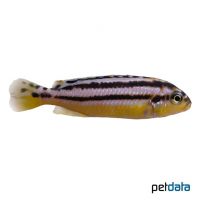Golden Mbuna (Melanochromis auratus)
| Golden Mbuna Melanochromis auratus | |
|---|---|
| Name | Golden Mbuna |
| Name Lat. | Melanochromis auratus |
| Synonym | Pseudotropheus auratus |
| Family | Cichlids |
| Family lat. | Cichlidae |
| Order | Cichlids |
| Order lat. | Cichliformes |
| Origin | Lake Malawi |
| Habitat | Rocky shore |
| Diet | Limnivore |
| pH | 7.5-8.8 |
| Behavior | Aggressive |
| Keeping | Harem |
| Care Level | Moderate |
| Reproduction | Mouthbrooder |
| Breeding | Simple |
| Life Span | 5-8 years |
| Protection | No |
| Metric Units | |
| Size | 10-12 cm |
| Temperature | 24-28 °C |
| Hardness | 10-25 °dH |
| Aquarium | 200 l |
| US Units | |
| Size | 4"-4.7" |
| Temperature | 75-82 °F |
| Hardness | 178-445 ppm |
| Aquarium | 50 gal |
Distribution and habitat
The distribution area of the turquoise goldfish is exclusively (endemic) the southern part of Lake Malawi, from Jalo Reef near Nkhotakota to Crocodile Rocks (Malawi). They belong to the Mbuna group, which lives in the rocky shore zones.
Maintenance
The aquarium setup should have rock structures reaching to the water surface, with many crevices, caves and shelters that serve as hiding places, as well as robust plants and some free sand areas. There should be no detectable ammonia, ammonium or nitrite, and the nitrate level should not exceed 100 mg/l. To ensure the water quality and oxygen content, a filter and heater adapted to the aquarium size is required, as well as lighting for the species-appropriate day-night rhythm of the animals.
Diet
They eat the vegetable cover (growth) of stones and the microorganisms contained therein. The food supply consists of algae leaves, crushed peas, pureed leafy and wild vegetables, and dry food with vegetable components, such as kelp and spirulina. In addition live food, such as Artemia, Cyclops and Daphnia, which is also accepted in frozen form, supplemented with frozen special food mixtures. A regular and varied diet promotes health and increases resistance. Only as much should be fed as is eaten immediately (in a maximum of 10 minutes).
Behaviour and compatibility
They are lively and very quarrelsome mbunas, both intraspecific and towards other fish. Males occupy territories only briefly, which they defend vigorously. They should be kept in a harem, one male with several females or better in a large group. In this way social structures are formed which reduce quarrels. Keeping a group is only recommended in a larger and richly structured tank. They can be socialized well with other robust cichlids from Lake Malawi, especially from the Mbuna group
Basically, only compatible fish species with similar demands on water conditions and water temperature should be socialized.
Sex dimorphism
The animals differ clearly in coloration (sexual dichromatism). The male is black with white to green-golden longitudinal stripes and has yellow egg spots on the anal fin.
Reproduction and breeding
They are maternal mouth brooders. Immediately after spawning, on a rock or in a small burrow, the females take the eggs into their throat sac for mouthbrooding. They keep the fry in their throat sac even after hatching. After about 4 weeks, the fry are released and brood care ends. During the entire brood care, the female does not take any food.
Fry must be fed several times a day with special rearing food (Artemia nauplii). In community tanks breeding is hardly possible, because the fry is easy prey.
Important
They are predatory mbunas that also feed on juveniles in the wild.
Occasionally, turquoise goldfish (Melanochromis auratus) are confused with the females and juveniles of chipoke mouthbrooders (Melanochromis chipokae)
Different Melanochromis species should not be kept together as they can interbreed (hybridize)
Red mosquito larvae should not be fed as they can damage the digestive tract
The well-being of the fish should be checked regularly. Temperature should be checked daily, pH, hardness and nitrate levels should be checked at least every 14 days. Regular partial water changes are recommended, even if the contaminant level has not yet reached the upper limit. Sudden changes in water quality should be avoided. Newly introduced fish must be accustomed slowly to the water in the aquarium.
Further literature can be found in your pet store.
References
Text: Werner Winter; Image: petdata
Source: BMELV (1998): Tierschutzgutachten - Haltung von Zierfischen (Süßwasser); RIEHL & BAENSCH (2006): Aquarien Atlas Bd. 1, Mergus Verlag; ENGELMANN (2005): Zootierhaltung - Tiere in menschlicher Obhut: Fische, Verlag Harri Deutsch
- Gemäß § 21 Abs. 5 Tierschutzgesetz idgF
